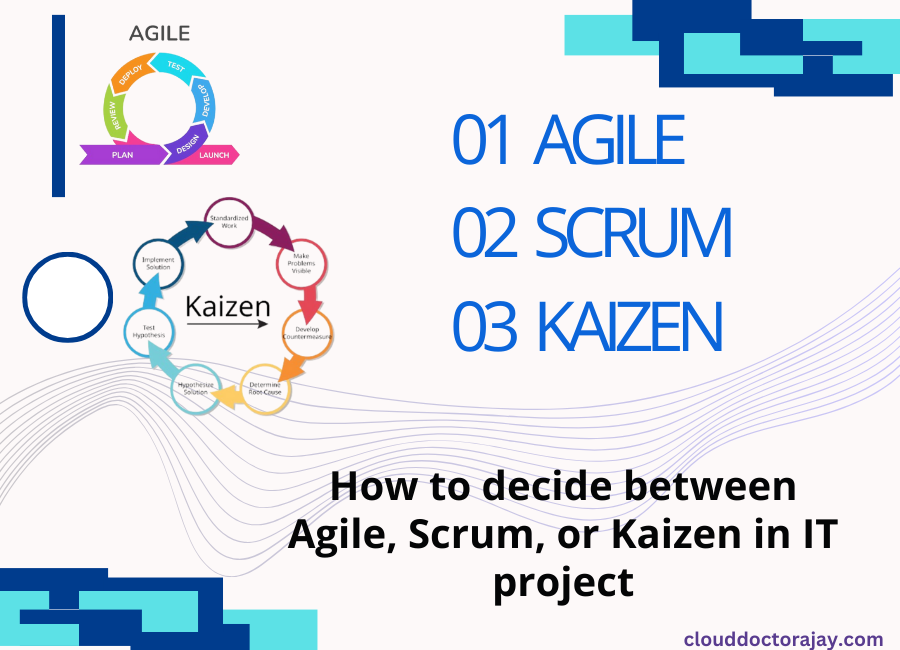For an IT project, choosing between Agile, Scrum, or Kaizen (Continuous Improvement) requires taking into account the unique requirements and features of the project, team, and company. When choosing this choice, keep the following things in mind:
Choosing between Agile, Scrum, or Kaizen
1. Nature and Features of the Project:
Agile: –
- Ideal for tasks that demand flexibility and have shifting requirements.
- Beneficial for projects where input and cooperation from customers are essential.
Scrum: –
- Offers an Agile mentality inside a disciplined framework.
- Effective for projects with intricate specifications, prioritizing iterative development and frequent feedback.
Kaizen: –
- Fit for initiatives where the main goal is to adopt an attitude of continuous improvement.
- Can be used to increase continuous improvement in conjunction with Agile or Scrum processes.
Unlocking Azure AI’s Potential for Developers: Guide to Tools and SDKs
2. Dynamic Team Environment:
Agile: –
- Adaptable and suitable for teams of all sizes.
- Agile methodology may be adopted by teams with diverse degrees of experience.
Scrum: –
- Demands that the team adhere to the roles, events, and artifacts of Scrum with a clear understanding.
- Performs admirably in teams of modest to moderate size.
Kaizen: –
- Depends on a culture of ongoing development, where team members must be involved and dedicated.
3. Environment of the Organization:
Agile: –
- Adaptability, flexibility, and teamwork are highly valued by firms that align well with agile practices.
- It is flexible enough to fit into different corporate cultures.
Scrum: –
- It is an Agile framework that may be implemented by organizations looking for a more structured approach.
- It necessitates the creation of positions such as Product Owner, Scrum Master, and Development Team.
Kaizen: –
- Fits in well with businesses that place a high value on a continuous improvement culture.
Streamlining Operations with One-Click Provisioning for On-Premise JD Edwards EnterpriseOne
4. Client Engagement:
Agile: –
- Promotes ongoing client input and involvement all the way through the project.
Scrum: –
- Assists the Product Owner in setting feature priorities in accordance with user requirements.
Kaizen: –
- May not be directly customer-focused, but it stresses process improvement for improved results.
5. Method for Handling Change:
Agile: –
- Places a strong emphasis on being flexible and attentive to customer demands.
Scrum: –
- Offers an organized framework that allows modifications within predetermined window of time (Sprints).
Kaizen: –
- Emphasizes making small, steady adjustments over time with an eye on continuous development.
6. Regulatory Requirements: –
Take into account if there are any particular regulations that apply to the project, since these could impact the decision between Agile, Scrum, or Kaizen.
7. Training and Adoption: –
Assess the group’s and the organization’s readiness to take up new techniques and training.
8. Prior Success: –
Take into account the accomplishments or difficulties the group or team had when implementing Agile, Scrum, or Kaizen in the past.
9. Combining Different Methodologies: –
Moreover, a combination of approaches can be used. For instance, a company may implement Kaizen principles for ongoing development and Agile concepts for project management, using Scrum.
10. Project Duration: –
Take into account how long the project is anticipated to take. While Kaizen is a continual improvement mindset that transcends particular projects, Agile and Scrum are applicable to both short- and long-term projects.
5 Best Project Management Software In 2023
Conclusion: –
In the end, the choice should be made after carefully considering the project specifications, team dynamics, and organizational objectives. To guarantee alignment with the selected technique, it could be helpful to confer with important stakeholders, such as project managers, team members, and organizational leadership.

